This is the current revision of this page, as edited by Binksternet (talk | contribs) at 21:12, 3 January 2025 (Binksternet moved page Falkands War order of battle: British naval forces to Falklands War order of battle: British naval forces: Misspelled). The present address (URL) is a permanent link to this version.
Revision as of 21:12, 3 January 2025 by Binksternet (talk | contribs) (Binksternet moved page Falkands War order of battle: British naval forces to Falklands War order of battle: British naval forces: Misspelled)(diff) ← Previous revision | Latest revision (diff) | Newer revision → (diff)This is a list of the naval forces from the United Kingdom that took part in the Falklands War, often referred to as "the Task Force" in the context of the war. For a list of naval forces from Argentina, see Argentine naval forces in the Falklands War.
Royal Navy


- Command
In Northwood, London:
- Commander-in-Chief, Fleet: Admiral Sir J.D.E. Fieldhouse
- Commander Task Group 324.3 and Flag Officer Submarines: Vice-Admiral P.G.M. Herbert
In the South Atlantic:
- Commander Task Group 317.8 (Carrier/Battle Group) and Flag Officer, First Flotilla: Rear-Admiral J.F. Woodward (HMS Hermes)
- Commander Task Group 317.0 (Amphibious Task Group) and Commodore Amphibious Warfare: Commodore M.C. Clapp (HMS Fearless)
- Centaur-class aircraft carrier - V/STOL carrier
- HMS Hermes - Flagship Task Group 317.8 (†3) 2 SHAR pilots
- Captain L.E. Middleton
- 800 Naval Air Squadron (12 BAE Sea Harriers, including 7 absorbed from 899 training squadron and trials)
- Lt Commander A.D. Auld
- part 809 Naval Air Squadron (4 BAE Sea Harriers absorbed into 800 Squadron)
- part No. 1 Squadron RAF (8 Hawker Siddeley Harrier GR.3)
- 825 Naval Air Squadron (4 Sea Kings HAS.2; formed from 706 training sqn)
- 826 Naval Air Squadron (12 Sea King HAS.5)
- Lt Commander D.J.S. Squier
- 846 Naval Air Squadron (6 Sea King HC.4)

- Invincible-class aircraft carriers
- HMS Invincible (†3) 2 SHAR pilots
- Captain J.J. Black RN
- 801 Naval Air Squadron (8 BAE Sea Harriers including 5 absorbed from 899 training squadron))
- Lt Commander N.D. Ward
- part 809 Naval Air Squadron (4 BAE Sea Harriers absorbed into 801 Squadron))
- 820 Naval Air Squadron (10 Sea King HAS.5)
- Lt Commander R.J.S. Wykes-Sneyd
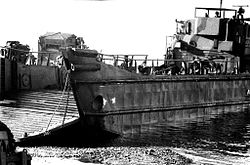
- HMS Fearless - Flagship Task Group 317.0 (†6)
- Captain E.S.J. Larken
- 4 LCU (Foxtrot One to Four), 100 troops or one Main Battle Tank. LCU Foxtrot Four, bombed and sunk in the Choiseul Sound by A-4B Skyhawks
- 4 LCVP (Foxtrot Five to Eight), 25 troops or a Land Rover with trailer.
- flight deck for 4 Sea King HC.4 (not embarked)

- HMS Intrepid
- Captain P.G.V. Dingemans
- 4 LCU (Tango One to Four)
- 4 LCVP (Tango Five to Eight)
- flight deck for 4 Sea King HC.4 (not embarked)

- HMS Bristol
- Captain A. Grose
- HMS Sheffield - set on fire by an Aérospatiale AM39 Exocet (Air-to-Surface) Anti-ship missile launched from a Dassault Super Étendard 4 May, (†20) - Fatal Damage (sank on 10 May)
- Captain J.F.T.G. Salt
- HMS Coventry - sunk on 25 May by three bombs from a Douglas A-4B Skyhawk (†19+1) - Fatal Damage
- Captain D. Hart Dyke
- HMS Glasgow - hit by unexploded bomb from a Douglas A-4B Skyhawk 12 May, withdrawn from war - Moderate Damage
- Captain A.P. Hoddinott
- HMS Cardiff
- Captain M.G.T. Harris
- HMS Exeter
- Captain H.M. Balfour
- HMS Glamorgan - hit by an Aérospatiale MM38 Exocet (surface-to-surface) anti-ship missile on 12 June (†14) - Major Damage
- Captain M.E. Barrow
- HMS Antrim - hit by unexploded bomb from an IAI Dagger - Major Damage
- Captain B.G. Young
- HMS Brilliant - hit by IAI Dagger cannon fire - Minor Damage
- Captain J.F. Coward
- HMS Broadsword - hit by IAI Dagger cannon fire, later damaged by bomb from Douglas A-4B Skyhawk - Moderate Damage
- Captain W.R. Canning

- HMS Active
- Commander P.C.B. Canter
- HMS Alacrity - sank Argentine transport ship ARA Isla de los Estados. Slightly damaged by bomb. Lynx helicopter damaged by return fire from armed coaster ARA Monsunen.
- Commander C.J.S. Craig
- HMS Antelope - sank 24 May due to unsuccessful defusing attempt of unexploded bombs from Douglas A-4B Skyhawks (†2) - Fatal Damage
- Commander N.J. Tobin
- HMS Ardent - sank 21 May by bombs from IAI Daggers and Douglas A-4Q Skyhawks (†22) - Fatal Damage
- Commander A.W.J. West
- HMS Ambuscade
- Commander P.J. Mosse
- HMS Avenger
- Captain H.M. White
- HMS Arrow - hit by IAI Dagger cannon fire - Minor Damage
- Commander P.J. Bootherstone
- HMS Andromeda
- Captain J.L. Weatherall
- HMS Argonaut - hit by Aermacchi MB.339A cannon/rocket and unexploded bombs from Douglas A-4B Skyhawks (†2) - Major Damage
- Captain C.H. Layman
- HMS Minerva
- Commander S.H.G. Johnston
- HMS Penelope
- Commander P.V. Rickard
- HMS Yarmouth
- Commander A.S. Morton
- HMS Plymouth - unexploded bombs from IAI Daggers - Major Damage
- Captain D. Pentreath
- HMS Rhyl - Ascension Island Guardship

- Ice patrol ship
- HMS Endurance
- Captain N.J. Barker
As despatch vessels, carrying mail between the Task Force and Ascension Island.
- HMS Leeds Castle
- Lt Commander C.F.B. Hamilton
- HMS Dumbarton Castle
- Lt Commander N.D. Wood
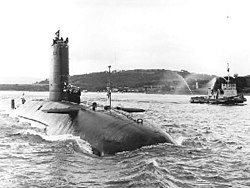
- Churchill-class submarines
- HMS Conqueror - sank ARA General Belgrano
- HMS Courageous
- Commander R.T.N. Best
- Oberon-class submarines
- HMS Onyx - ran aground - Moderate Damage
- Lieutenant-Commander A. O. Johnson
- Valiant-class submarines
- HMS Valiant - Argentine fighters returning from an aborted mission jettisoned bombs nearby - Minor Damage
- Commander T.M. Le Marchand
- Swiftsure-class submarines
- HMS Spartan
- Commander J.B. Taylor
- HMS Splendid
- Commander R.C. Lane-Nott
- Hecla-class survey vessels
2,744 t, used as casualty ferries (hospital ships)
- HMS Hecla
- Captain G.L. Hope
- HMS Herald
- Commander R.I.C. Halliday
- HMS Hydra
- Commander R.J. Campbell
- Trawler/Minesweepers - Minesweeper Auxiliary (MSA) 11th MCM Squadron
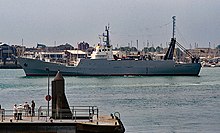
Civilian trawlers converted to Extra-Deep Armed Team Sweep (EDATS) with some extempore acoustic and sonar equipment. They were crewed by Royal Naval personnel, mainly from 1st MCM Squadron based at Rosyth. All five minesweepers were involved in clearing two minefields off Port Stanley.
- HMS Cordella 1,238 GRT
- Lieutenant-Commander M. Holloway
- HMS Farnella 1,207 GRT
- Lieutenant R. Bishop
- HMS Junella 1,615 GRT
- Lieutenant-Commander M. Rowledge
- HMS Northella 1,238 GRT
- Lieutenant-Commander J. Greenop
- HMS Pict 1,478 GRT
- Lieutenant-Commander D. Garwood
Royal Fleet Auxiliary

Tankers
- RFA Olna (A123) 36,000 t
- J.A. Bailey
- RFA Olmeda (A124) 36,000 t
- G.P. Overbury
- RFA Tidespring (A75) 27,400 t
- S. Redmond
- RFA Tidepool (A76) 27,400 t
- J.W. Gaffrey
- RFA Blue Rover (A270) 11,522 t
- D.A. Reynolds
- RFA Appleleaf (A79) 40,870 t
- G.P.A. McDougall
- RFA Brambleleaf (A81) 40,000 t
- M.S.J. Farley
- RFA Bayleaf (A109) 40,000 t
- A.E.T. Hunter
- RFA Plumleaf (A78) 25,790 t
- R.W.M. Wallace
- RFA Pearleaf (A77) 25,790 t
- J. McCulloch
Landing Ship Logistic
The peacetime crews of the Round Table-class ships – British merchant seamen, operating under Ministry of Defence jurisdiction – were joined by British servicemen as signalmen, stevedores and gunners.
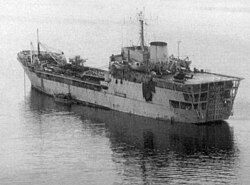 |
 |
- RFA Sir Bedivere (L3004) - bombed by Douglas A-4B Skyhawk - Minor Damage
- P.J. McCarthy
- RFA Sir Galahad (L3005) - bombed on 24 May and 8 June by Douglas A-4B Skyhawks (sunk by torpedo on 21 June and declared a war grave) (†48) - Fatal Damage
- Paul J.G. Roberts
- RFA Sir Geraint (L3027)
- D.E. Lawrence
- RFA Sir Lancelot (L3029) - damaged by unexploded bombs from Douglas A-4B Skyhawks
- Christopher A. Purtcher-Wydenbruck
- RFA Sir Percivale (L3036)
- A.F. Pitt
- RFA Sir Tristram (L3505) - bombed 8 June by Douglas A-4B Skyhawks (†2) - Major Damage
- G.R. Green
Supply ships
- RFA Regent (A486) 22,890 t
- J. Logan
- RFA Resource (A480) 22,890 t
- B.A. Seymour
- RFA Fort Austin (A386) 23,600 t
- Commodore Sam Dunlop RFA (S C Dunlop)
- RFA Fort Grange (A385) 23,600 t
- D.G.M. Averill
- RFA Stromness (A344) 16,792 t - attacked by A-4C on 24 May - Minor Damage
- J.B. Dickinson
Helicopter support ship
- RFA Engadine (K08) 9,000 t
- D.F. Freeman
Royal Maritime Auxiliary Service
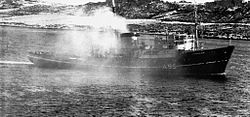
Ships taken up from trade

The following Merchant Navy ships were requisitioned, as Ships Taken Up From Trade (STUFT).
- Liners
- SS Canberra 44,807 GRT – equipped with helicopter pad and carried personnel of the 3rd Commando Brigade to San Carlos on 21 May.
- MV Queen Elizabeth 2. 67,140 GRT – equipped with helicopter pad and carried 3,200 men of the 5th Infantry Brigade. At South Georgia, the men of 2nd Battalion Scots Guards, 1st Battalion Welsh Guards and 1/7 Gurkha Rifles were transferred to Canberra, Norland and RFA Stromness on 27 May for transport to San Carlos.
- SS Uganda 16,907 GRT – equipped with helicopter pad and used as hospital ship from 11 May.
- Elk 5,463 GRT – equipped with helicopter pad and two Bofors 40 mm guns to carry three Sea King helicopters, ammunition, and heavy vehicles including eight Bofors 40 mm guns, four FV101 Scorpion and four FV107 Scimitar light tanks - joined carrier battle group on 16 May
- Baltic Ferry 6,455 GRT – equipped with helicopter pad and carried three Army helicopters, 105 troops, and 1,874 tons of stores and ammunition to Ajax Bay on 1 June
- Europic Ferry 4,190 GRT – equipped with helicopter pad and carried vehicles, ammunition, fuel, and four Scout helicopters of 656 Squadron Army Air Corps to San Carlos on 21 May
- Nordic Ferry 6,455 GRT – equipped with helicopter pad and carried troops, stores, and ammunition to Falklands on 29 May
- Norland 12,990 GRT – equipped with helicopter pad carried 800 men of 2 Para and men of 848 Naval Air Squadron to San Carlos on 21 May
- Rangatira 9,387 GRT – equipped with helicopter pad and Oerlikon 20 mm cannon to carry 1,000 engineers with vehicles and equipment, but sailed after cease fire.
- St Edmund 8,987 GRT – equipped with helicopter pad and carried RAF crews (18 Sqn), troops and vehicles
- Tor Caledonia 5,056 GRT – equipped with helicopter pad and carried vehicles and equipment; arrived 12 June
- Container / Cargo ships
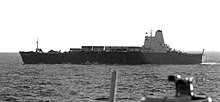
- Astronomer 27,867 GRT – equipped with helicopter pad and Oerlikon 20 mm cannon and carried thirteen helicopters; arrived after cease fire.
- Atlantic Conveyor 14,946 GRT – equipped with helicopter pad and carried eight BAE Sea Harriers (809 Squadron - aircraft later transferred to the two carriers), six Hawker Siddeley Harriers, six Westland Wessex helicopters, and four CH-47 Chinook helicopters (18 Squadron RAF); arrived 19 May - hit 25 May by one or two Aérospatiale AM39 Exocet Air-to-Surface Anti-ship missile(s) launched from a Dassault Super Étendard (†12) - Fatal Damage: Sank in tow 28 May - 6 embarked Wessex HU.5 helicopters, 3 embarked Chinook HC.1 helicopters, 1 embarked Sea Lynx HAS.2, heavy equipment intended for airfield construction, and the bulk stock of tents intended for infantry shelter ashore were lost
- Atlantic Causeway 14,946 GRT – equipped with helicopter pad and carried eight ASW Sea Kings and twenty Westland Wessex helicopters; arrived 27 May.
- Contender Bezant 11,445 GRT – equipped with helicopter pad and carried 9 Wasp helicopters, 4 Harriers and 3 Chinooks; arrived after cease fire. - purchased as RFA Argus post-war
- MV Myrmidon 23,413 GRT-equipped with tented accommodation and Portakabins armed with 20mm Oerlikon cannons, arrived after ceasefire
- Freighters

- Avelona Star 9784 GRT (refrigerated) – equipped with helicopter pad and carried provisions; arrived after cease fire
- Geestport 7,730 GRT (refrigerated) – equipped with helicopter pad and carried provisions and stores; arrived 11 June
- Laertes 11,804 GRT – Soviet-built with armored cable trunks and damage control centers - carried general supplies; arrived after cease fire
- Lycaon 11,804 GRT – Soviet-built with armored cable trunks and damage control centers - carried ammunition and supplies; arrived 28 May
- Saxonia 8,547 GRT (refrigerated) – carried provisions; arrived 23 May
- Strathewe 12,598 GRT – carried supplies and landing craft; arrived after cease fire
- St Helena 3,150 GRT – equipped with helicopter pad and four Oerlikon 20 mm cannon for use as minesweeper support ship after the cease fire
- Tankers
- Alvega 33,000 t (57,372 DWT) – used as base storage tanker at Ascension from mid-May
- Anco Charger 24,500 DWT – used as auxiliary support tanker from 24 April with capability to transport 42 different liquids at once
- Balder London 19,980 t (33,751 DWT) – used as auxiliary support tanker from 12 May
- British Avon 15,640 t (25,620 DWT) – used as auxiliary support tanker from 25 April
- British Dart 15,650 t (28,488 DWT) – used as auxiliary support tanker from 22 April
- British Esk 15,643 t (25,905 DWT) – fitted with over-the-stern underway refueling equipment for use as the first convoy escort oiler
- British Tamar 15,646 t (25,498 DWT) – fitted with over-the-stern underway refueling equipment for use as convoy escort oiler from 13 April
- British Tay 15,650 t (25,650 DWT) – used as auxiliary support tanker from 12 April
- British Test 16,653 t (25,641 DWT) – used as auxiliary support tanker from 14 April
- British Trent 15,649 t (25,147 DWT) – used as auxiliary support tanker from 18 April
- British Wye 15,649 t (25,197 DWT) – used as auxiliary support tanker from 25 April - hit by bomb from Lockheed C-130 Hercules - Minor Damage
- Eburna 19,763 t (31,374 DWT) – used as auxiliary support tanker from 26 April
- Fort Toronto 25,498 DWT – fresh water tanker from 19 April
- G.A.Walker 18,744 t (30,607 DWT) – used as auxiliary tanker from 10 June
- Scottish Eagle 33,000 t (54,490 DWT) – used as base storage tanker at South Georgia from 18 June and then moved to Falklands on 14 July
- Tugs / Repair / Support Ships
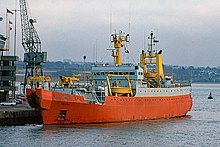

- British Enterprise III 1,595 t – diving support ship
- Iris 3,873 GRT – cable ship equipped with helicopter pad and two Oerlikon 20 mm cannon for use as despatch vessel from late May.
- Irishman 686 GRT – ocean salvage tug from 24 May.
- Salvageman 1,598 GRT – ocean salvage tug from 7 May.(the most powerful tug on British registry with 11,000 brake horsepower and 170 ton bollard pull)
- Stena Inspector 5,814 GRT – equipped with helicopter pad and used as repair ship after the cease fire. - purchased as RFA Diligence post-war
- Stena Seaspread 6,061 GRT – diving vessel, oilfield support ship equipped with helicopter pad and used as repair ship from 16 May. "Quote": Supreme effort to prepare fleet for battle: Not for the first time has the versatility and technological capability of the offshore support fleet astounded the military - it only comes as a surprise to those not familiar with the offshore oil industry and the demands it places on ships and those crewing them, that the navies of the world do not have the same level of technology available and their personnel often lack the same levels of skills and experience. Most noteworthy was the MSV Stena Seaspread, a refitted diving and maintenance vessel which was taken to the Falklands to act as a floating workshop for the warships. During the period of hostilities the MSV Stena Seaspread carried out damage and other repairs in mid-ocean to more than 50 ships, including 10 warships and 4 captured vessels.
- Wimpey Seahorse 1,599 GRT – oilfield supply vessel used as mooring tender and tug from 8 June.
- Yorkshireman 686 GRT – ocean salvage tug from 24 May.
Weaponry


- Surface-to-air missiles
- Surface-to-surface missiles
- Artillery
- Torpedoes
- Mark 24 Tigerfish torpedo
- Mark 8 torpedo
See also
Notes
- "British Task Force - Falklands War 1982". Naval History. 31 May 2013.
- Sir Lawrence Freeman (2005). The Official History of the Falklands Campaign. Routledge. ISBN 0-7146-5207-5.
- ^ Morison (June 1983) pp.119-124
- Chard sailor's Falkland experience
- West, Nigel (2010). Historical Dictionary of Naval Intelligence. Scarecrow Press, pp. 63-64. ISBN 0-8108-6760-5
- ^ Baker (June 1983) pp.111-118
- "The War Within". South China Morning Post. 10 June 2007.
- Roberts, P.J. (January 1984). "RFA Sir Galahad - The Demise of a Gallant Knight" (PDF). The Naval Review. 72 (1): 53–58. Archived from the original (PDF) on 16 August 2017. Retrieved 19 August 2017.
- Villar (1984) p.171
- Trotter (June 1983) pp.108-111
- Villar (1984) pp.49&173
- ^ Villar(1984)p.183
- Villar (1984) pp.9,37-38,40&171
- Villar (1984) pp.43&173
- Villar (1984) pp.44&172
- Villar (1984) p.173
- Villar (1984) pp.31&172
- Villar (1984) pp.28&174
- "British Railways - Sealink".
- ^ Villar (1984) p.180
- Villar (1984) pp.87&179
- Villar (1984) pp.37&178-179
- Villar (1984) pp.84&179
- Villar (1984) pp.86&179
- Villar (1984) pp.95&180
- Villar (1984) p.179
- ^ Villar (1984) p.182
- ^ Villar (1984) p.53
- ^ Villar (1984) p.169
- ^ Villar (1984) p.176
- ^ Villar (1984) p.174
- Villar (1984) p.175
- Villar (1984) p.101
- Villar (1984) p.116&182
- Villar (1984) pp.67&178
- Villar (1984) p.178
- http://www.thenewscentre.co.uk/falklands
References
- Baker, A.D.III (June 1983). "Sealift, British Style". United States Naval Institute Proceedings.
{{cite journal}}: Cite journal requires|journal=(help) - Clapp, Michael; Southby-Tailyour, Ewen (1996). Amphibious Assault Falklands. Leo Cooper. ISBN 0-85052-420-2.
- Hastings, Max; Jenkins, Simon (1983). The Battle for the Falklands. Michael Joseph Ltd. ISBN 0-7181-2228-3.
- Morison, Samuel L. (June 1983). "Falklands (Malvinas) Campaign: A Chronology". United States Naval Institute Proceedings.
{{cite journal}}: Cite journal requires|journal=(help) - Puddefoot, Geoff (2007). No Sea Too Rough. Chatham Publishing. ISBN 978-1-86176-314-3.
- Trotter, Neville (June 1983). "The Falklands and the Long Haul". United States Naval Institute Proceedings.
{{cite journal}}: Cite journal requires|journal=(help) - Villar, Roger (1984). Merchant Ships at War The Falklands Experience. Naval Institute Press. ISBN 0-87021-845-X.
External links
- Ships of the Royal Navy - Royal Fleet Auxiliary - Merchant Navy
- STUFT Photo Gallery Archived 4 March 2016 at the Wayback Machine
| Falklands War | |
|---|---|
| Timeline | |
| Battles | |
| Operations | |
| Forces | |
| Ships | |
| Related | |